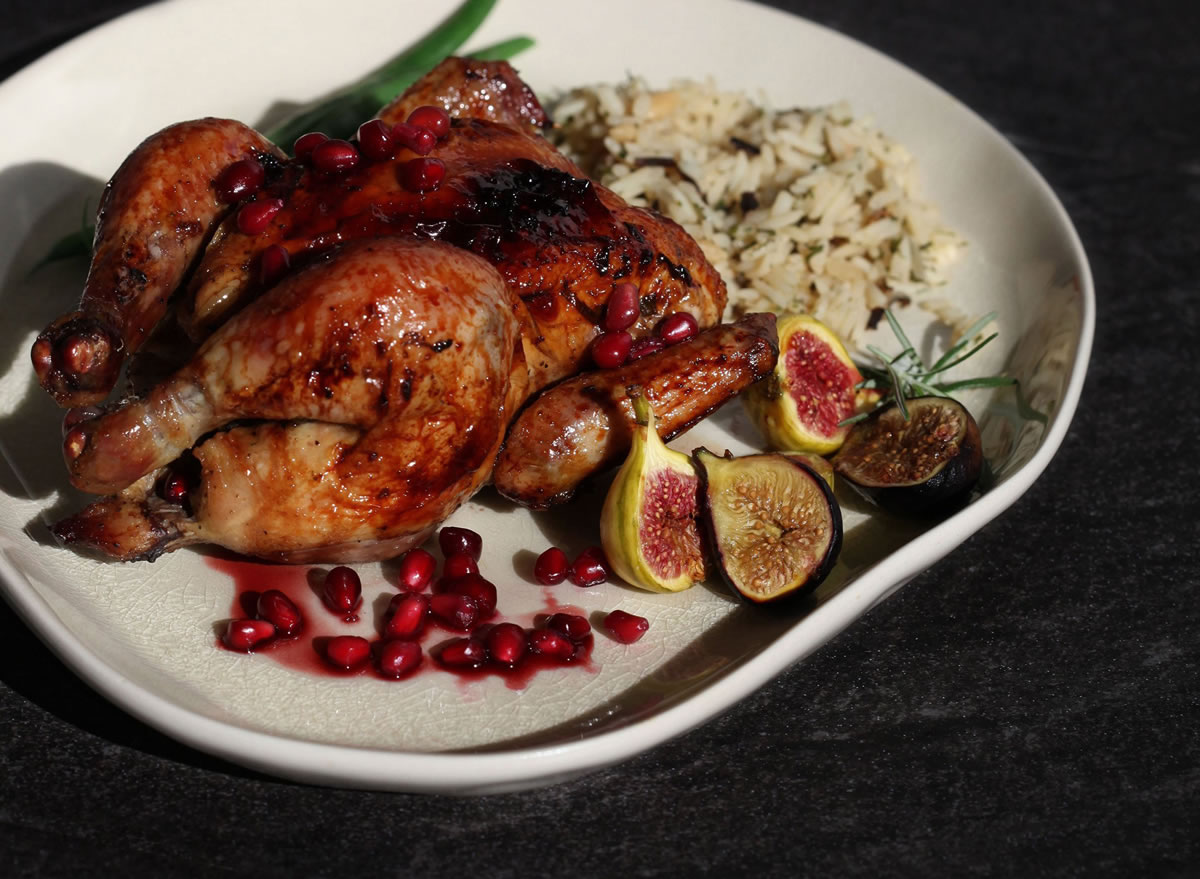In cookbooks and magazines, figs have been catching my eye lately.
Some have been drizzled with honey or oil and roasted. Others are stewed in a red wine and served as a dessert. I’ve even seen them made into compote and served as an appetizer on crusty baguette slices topped with Gorgonzola cheese.
In season from June to October, figs are a fruit that can exude a sense of elegance, especially when paired with savory ingredients.
Available fresh or dried, figs can be found in most stores. Most often you’ll find the Mission fig, which has purplish-black skin, and the Calimyrna, a California version of the Mediterranean Smyrna; it has light green skin and white flesh. Both varieties have tiny edible seeds and a plump pear shape.
Figs can be fussy because they are highly perishable and have a short shelf life. When you buy figs, keep them refrigerated and use them within a few days.
In today’s recipe, the figs are treated simply: roasted with a drizzling of honey and a sprinkling of salt. They pair nicely with Cornish hens flavored with another fall favorite: pomegranate.
Cornish hens are small, young chickens. You’ll find them typically sold frozen, wrapped individually and two to a package. Each bird weighs about 1 to 1 1/4 pounds. They cook quickly when butterflied.
To split the hen, turn it over so it is breast-side down. Using a good pair of kitchen shears, remove the backbone of the hen, cutting along each side of it. Then cut the hen in half along the breastbone and flatten. Or, you can leave the bird whole.
During roasting, the Cornish hens are glazed with pomegranate molasses, a thick, syrupy and sweet reduction of pomegranate juice. You can buy pomegranate molasses in the ethnic aisle at some grocery stores. But it’s just as easy to make your own (see recipe).
The reduction is a good match for Cornish hens and figs because it adds a sweet touch. Serve this dish with a quick saute of green beans and wild rice blend.
Cornish Hens With Pomegranate Glaze and Roasted Figs
Serves: 4. Preparation time: 1 hour. Total time: 2 hours, 15 minutes.
Serve a salad garnished with pomegranate aerials along with a side of greens beans and rice blend to make a complete meal. From and tested by Susan Selasky for the Free Press Test Kitchen.
FOR THE HENS:
4 Cornish hens, thawed if frozen, giblets removed for another use
4 tablespoons unsalted butter, softened
2 tablespoons mixed fresh herbs (basil, Italian parsley, oregano)
1 teaspoon Morton’s Nature’s Seasons seasoning blend or kosher salt and black pepper to taste
1 1/2 to 2 cups chicken broth
FOR THE POMEGRANATE GLAZE:
2 cups pomegranate juice
2 tablespoons brown sugar
2 teaspoons of lemon juice
FOR THE FIGS:
1 1/2 packages (about 12 ounce) Mission or Calimyrna figs, cut in half
Honey or agave
Kosher salt
To prepare the Cornish hens: Remove the hens from the packaging and pat dry. If desired, cut out the back and butterfly them. Place on a sided baking sheet or shallow roasting pan and refrigerate for at least one hour or longer to let the skin dry.
Remove the hens from the refrigerator at least one hour before roasting.
Meanwhile make the herb butter and pomegranate glaze: In a small bowl, mix butter and herbs and set aside.
To make the pomegranate glaze, in a saucepan combine the pomegranate juice, brown sugar and lemon juice. Bring just to a boil over medium-high heat and stir until the sugar has dissolved. Reduce the heat to medium and simmer a good 30 to 40 minutes or until the mixture is reduced by half and thick enough to coat the back of a spoon. Remove from heat and set aside. It will continue to thicken.
Place the figs, cut side up, on a sided baking sheet and drizzle with honey; set aside.
Preheat the oven to 375 degrees. Season the cavity and the outside of the Cornish hens with seasoning blend or salt and pepper. Tie the legs together. Arrange the hens on a sided baking sheet or rack set in a shallow roasting pan. Place a dollop of the herb butter on the breast of each hen. Pour 1 cup of the broth in the bottom of the pan. Place in the oven and roast 10 minutes. Spoon some of the glaze on each one. Continue roasting, basting (add more broth to pan if needed) with the glaze every 15 minutes or so. Cook until the hens are browned and cooked throughout, about 50 minutes to 1 hour total. Remove the hens from the oven and transfer to a platter.
While hens rest, place the figs in the oven and roast about 10 minutes or until lightly caramelized. Arrange roasted figs around the hens and serve.
Nutritional analysis: Analysis per 1 whole cornish hen with skin and 2 tablespoons glaze. 02 calories (38 percent from fat), 21 grams fat (10 grams sat. fat), 24 grams carbohydrates, 53 grams protein, 758 mg sodium, 266 mg cholesterol, 2 grams fiber.



